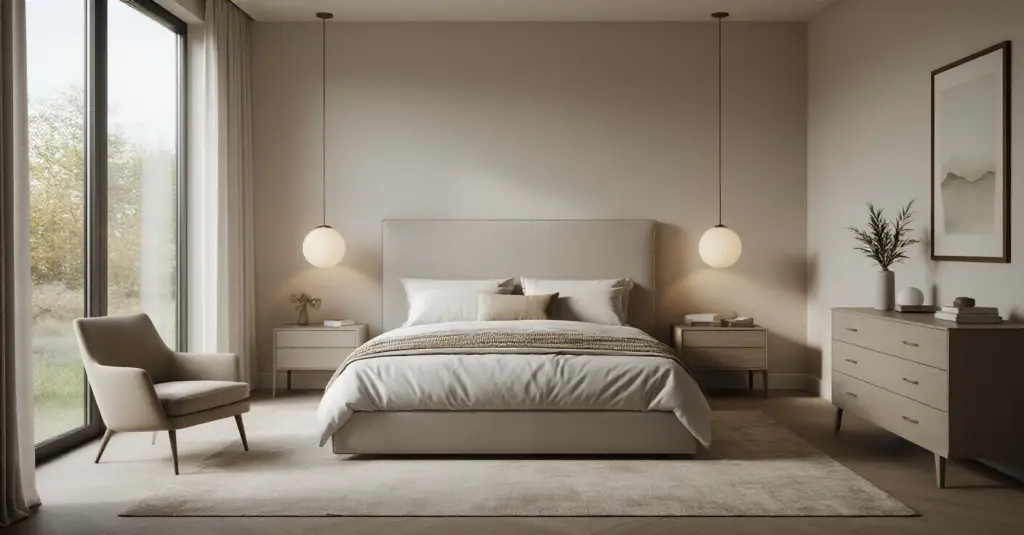Can we talk about why everyone gets “cozy” wrong? Seriously. It’s my biggest pet peeve. People see a picture online, throw a chunky knit blanket on the bed, add some string lights, and wonder why their bedroom still feels… off. They think cozy is a style you can buy, like a new set of pillows. But it’s not.
Here’s the truth they miss: Coziness isn’t a thing, it’s a feeling. It’s a system. It’s the silent sigh of relief you breathe when you walk into a room that just feels right. It’s about safety, warmth, and tranquility. And it starts with foundational layers that most people completely ignore. I’m here to give you the real story, the architectural designer’s take, so you can stop wasting money on trendy decor and start building a space that actually restores you.
Laying the Foundational Layers for Comfort (Part 1)
Before you even think about buying a new throw pillow, we have to talk about the bones of your room. These are the non-negotiable elements that set the stage for everything else. Get these right, and the cozy feeling follows naturally. Ignore them, and you’ll just be putting expensive lipstick on a pig. We’re talking about the invisible architecture of comfort—layout, light, and color—the things that subconsciously tell your brain whether to relax or stay on high alert.
1. Optimize Room Layout for Serene Flow and Restfulness
The way your furniture sits in a room is like grammar in a sentence. If it’s wrong, the whole thing feels clunky and unsettling, even if you can’t put your finger on why. The goal is to create a layout that feels both open and secure. Your bed should be the clear focal point, preferably against a solid wall where you can see the door but aren’t directly in line with it. This is an ancient Feng Shui principle that taps into our primal need to feel safe and in control of our surroundings. You need to be able to see who’s coming, without being the first thing they see.
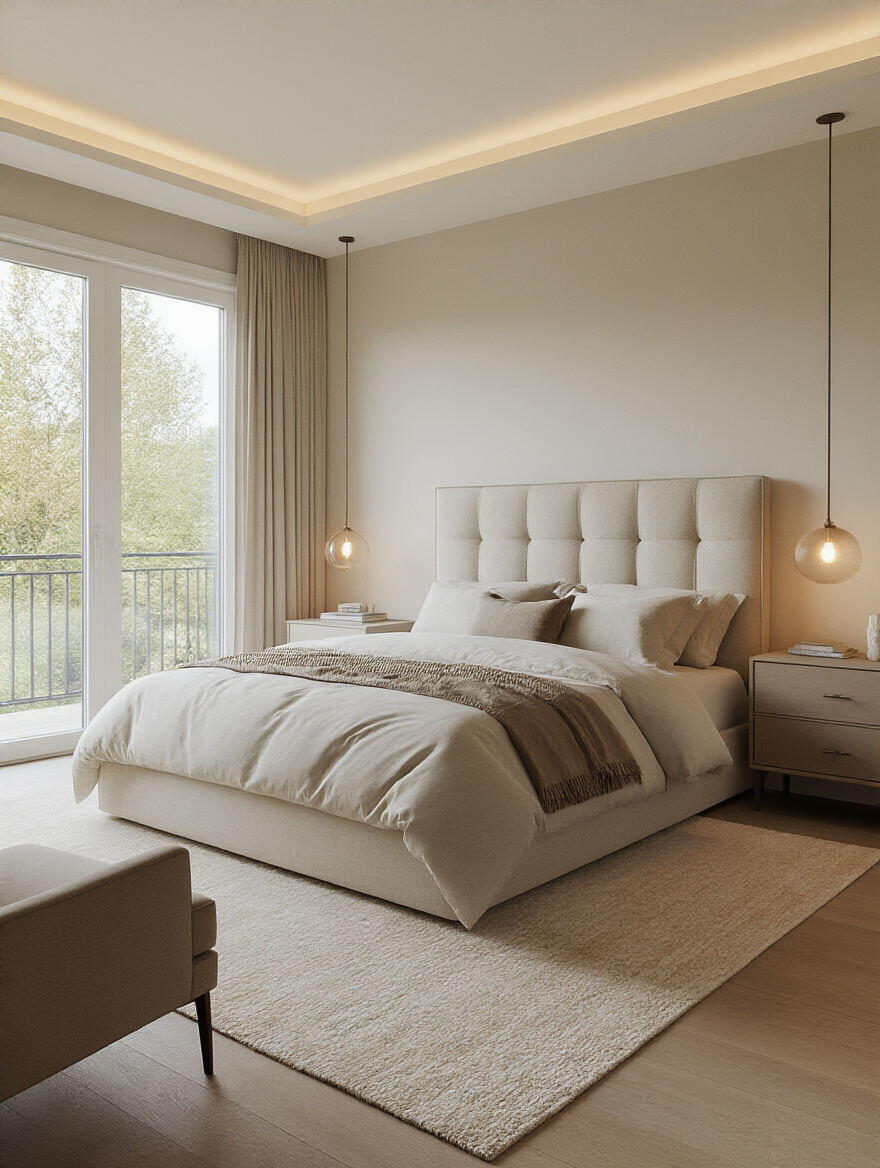
Once the bed is placed, you must create clear pathways. You need at least two, preferably three, feet of walking space around the bed and major furniture. This isn’t just for avoiding stubbed toes in the middle of the night; it’s about reducing subconscious stress. A cramped room feels like a cluttered mind. I once worked with a client whose bedroom was technically large, but they felt anxious in it. All we did was pull their dresser off one wall and move their bed to another to create better flow. Their sleep quality improved almost immediately. It’s that powerful.
With the core flow established, we can tackle the biggest enemy of calm: clutter.
2. Declutter Ruthlessly to Cultivate Visual Calmness
Think of clutter as “visual noise.” Every out-of-place object is screaming for a tiny piece of your attention, and in the one room where your brain is supposed to be powering down, that’s a disaster. Getting rid of this noise is non-negotiable. This isn’t about sterile minimalism; it’s about being incredibly intentional. Every single thing in your bedroom should either be beautiful or useful. If it’s neither, it doesn’t belong there.

Start small so you don’t get overwhelmed. One drawer. The top of your nightstand. Be ruthless. If you haven’t used it in a year, it goes. Find a permanent, hidden home for everything that stays—under the bed, in a closet, inside an ottoman. The goal is to create clean, calm surfaces that give your eyes a place to rest. The less your brain has to process, the easier it is to transition into a state of relaxation. Remember, a peaceful room cultivates a peaceful mind.
Now that the space is clear, let’s talk about the single most impactful element for setting a mood: color.
3. Select a Soothing Color Palette for Tranquil Walls
The color on your walls is constantly sending signals to your brain. You can’t turn it off. So, using vibrant, high-energy colors like bright red or electric yellow in a bedroom is like trying to fall asleep at a rave. It works against your biology. We need colors that communicate safety and serenity—think muted blues, soft greens, earthy taupes, or even a sophisticated, warm off-white. These colors mimic tones found in nature, which our brains are hardwired to find calming.
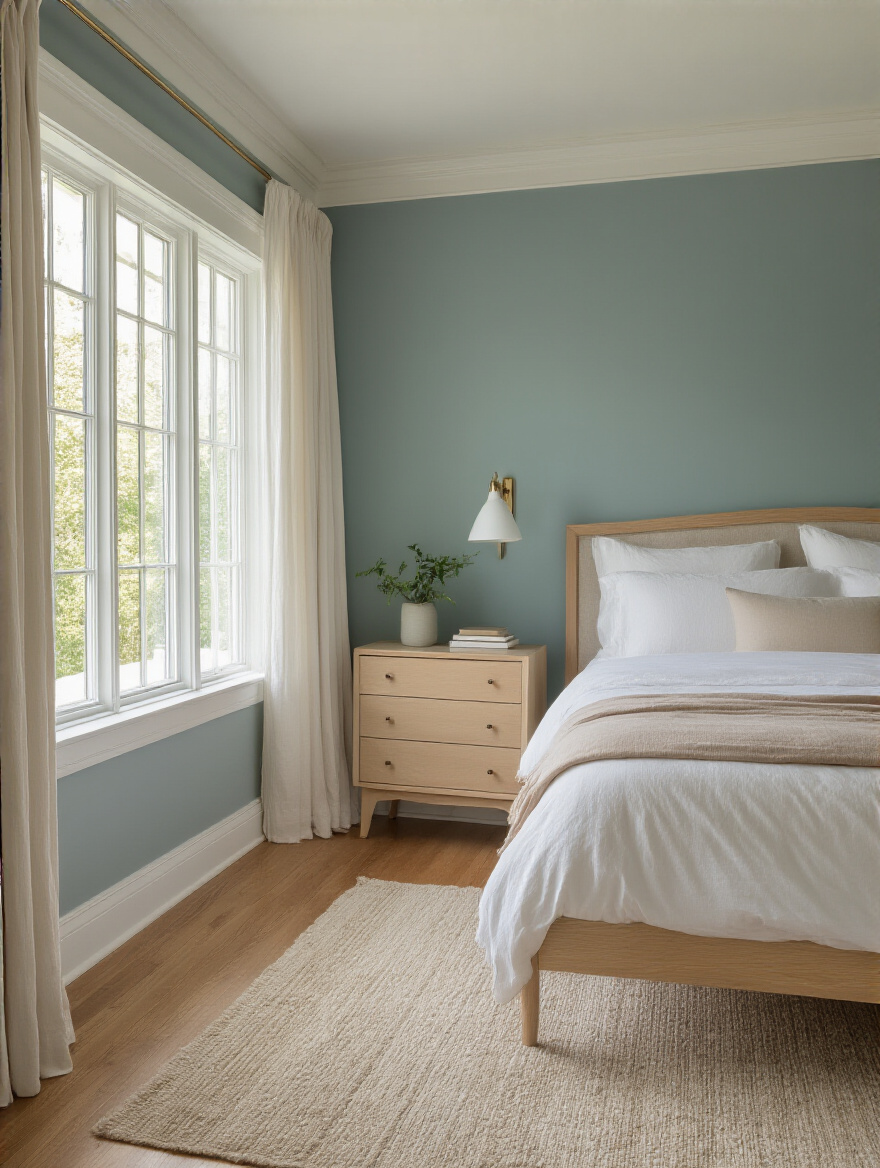
But here’s the shortcut most people miss: always, always test paint swatches on your actual walls. Paint two coats on a large poster board and move it around the room at different times of the day. The way light hits a wall can completely change a color’s undertone. That “calm gray” you loved at the store might look like a depressing purple under your room’s evening light. Your room’s orientation (north-facing rooms get cooler light, south-facing get warmer) makes a huge difference. Getting the color right is foundational to getting the feeling right.
Speaking of light, this is where the real magic happens. This is my world.
4. Strategically Layer Warm and Dimmable Lighting Options
This is it. This is the secret ingredient. Can we please stop putting one harsh, central “boob light” in the middle of the ceiling and calling it a day? That kind of single-source overhead lighting creates harsh shadows and a flat, sterile environment. It’s interrogation-room lighting, not sanctuary lighting. Good lighting is about creating layers and pools of light that give a room depth and soul.

You need at least three layers.
- Ambient: This is your general, room-filling light. It can be an overhead fixture, but it MUST be on a dimmer and use a warm bulb.
- Task: This is focused light for specific activities, like a reading lamp by your bed or a light over a vanity. It lets you see what you’re doing without flooding the whole room.
- Accent: This is the fun part. It’s a small lamp in a corner, uplighting on a plant, or a soft glow from a shelf. This is the layer that creates mood and makes a space feel intimate and alive.
The absolute key to a cozy feel is color temperature, measured in Kelvin (K). Look for bulbs that are 2700K or lower. This gives you that warm, candle-like glow that’s perfect for winding down. Anything over 3000K starts getting cool and blue, which tells your brain it’s the middle of the day and suppresses melatonin production. Put everything on a dimmer. All of it. Control over light intensity is control over the room’s entire mood.
Laying the Foundational Layers for Comfort (Part 2)
We’ve covered the atmosphere, but what about the physical machine you sleep on? Creating a true sanctuary means ensuring the core components are designed for deep, restorative rest. It’s the stuff that isn’t glamorous but makes all the difference in how you actually feel when you wake up.
5. Prioritize a Premium Mattress and Sturdy Bed Base for Core Comfort
You can have the most beautifully designed bedroom in the world, but if your mattress feels like a pile of rocks or a saggy hammock, you’ll never get restorative rest. Your bed is not a piece of furniture; it’s a piece of performance equipment for sleep. Investing in a high-quality mattress that suits your sleep style (side, back, stomach) is the single most important purchase you will make for your bedroom. It is the literal foundation of your comfort.
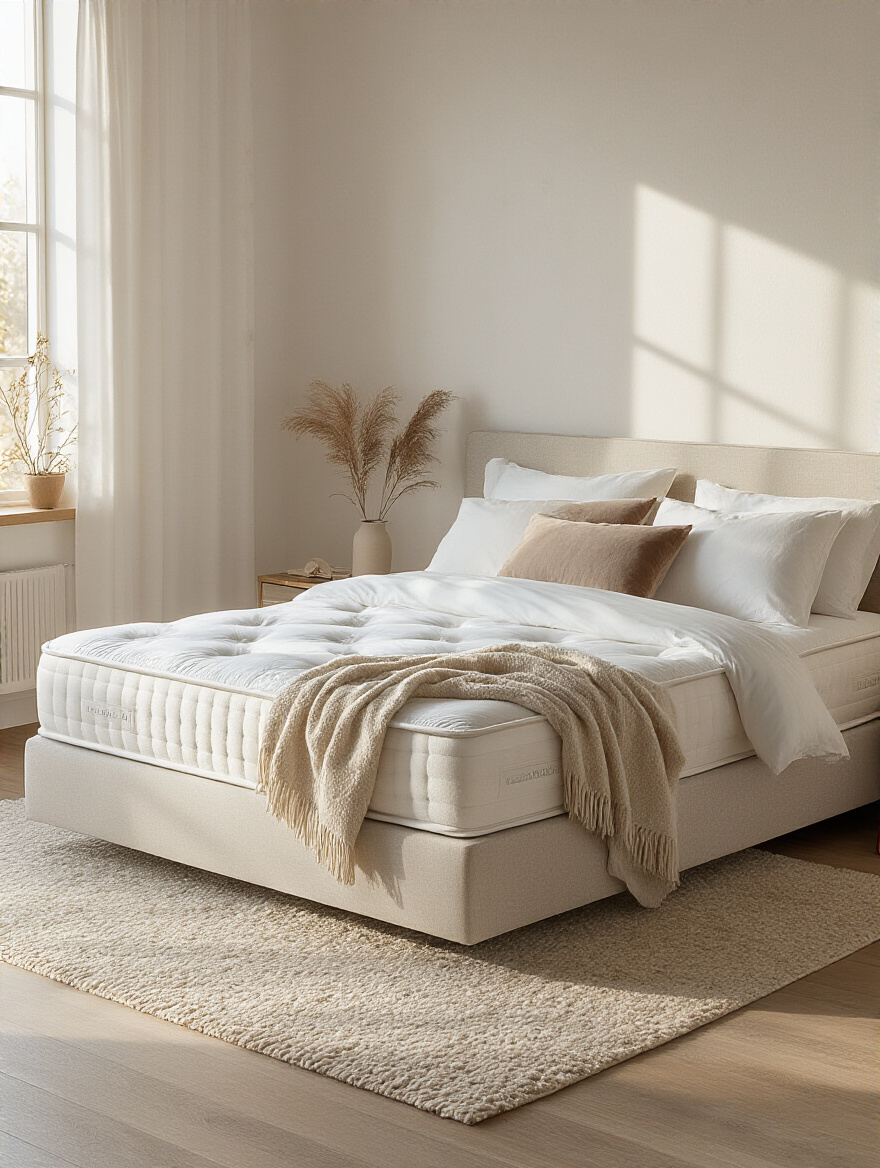
And don’t forget its partner: the bed base. Putting a brand new, high-tech mattress on a flimsy, sagging frame or broken box spring is like putting premium tires on a car with a bent axle. The base ensures your mattress performs the way it was designed to, providing even support and preventing premature sagging. A solid foundation is crucial for spinal alignment and can even extend the life of your mattress. Stop thinking of these as expenses and start thinking of them as non-negotiable investments in your health.
Now that the fundamental physical comfort is handled, we can start adding the sensory layers that truly define coziness.
Embracing Textures and Sensory Elements (Part 1)
This is where we engage the senses beyond sight. Coziness is a tactile experience as much as it is a visual one. The feel of fabrics against your skin, the softness under your feet, and even the temperature of the air all contribute to that enveloping feeling of comfort we’re chasing.
6. Layer Up with Luxurious Bedding for Inviting Tactile Comfort
Your bed should be a nest you can’t wait to climb into every night. The key to achieving that is by layering different materials and textures. Don’t just throw a comforter on and call it a day. Start with high-quality sheets in a natural, breathable fiber like cotton, linen, or bamboo. Then add a duvet, a quilt or coverlet, and fold a textured throw blanket at the foot of the bed. It’s about creating a rich, tactile landscape.
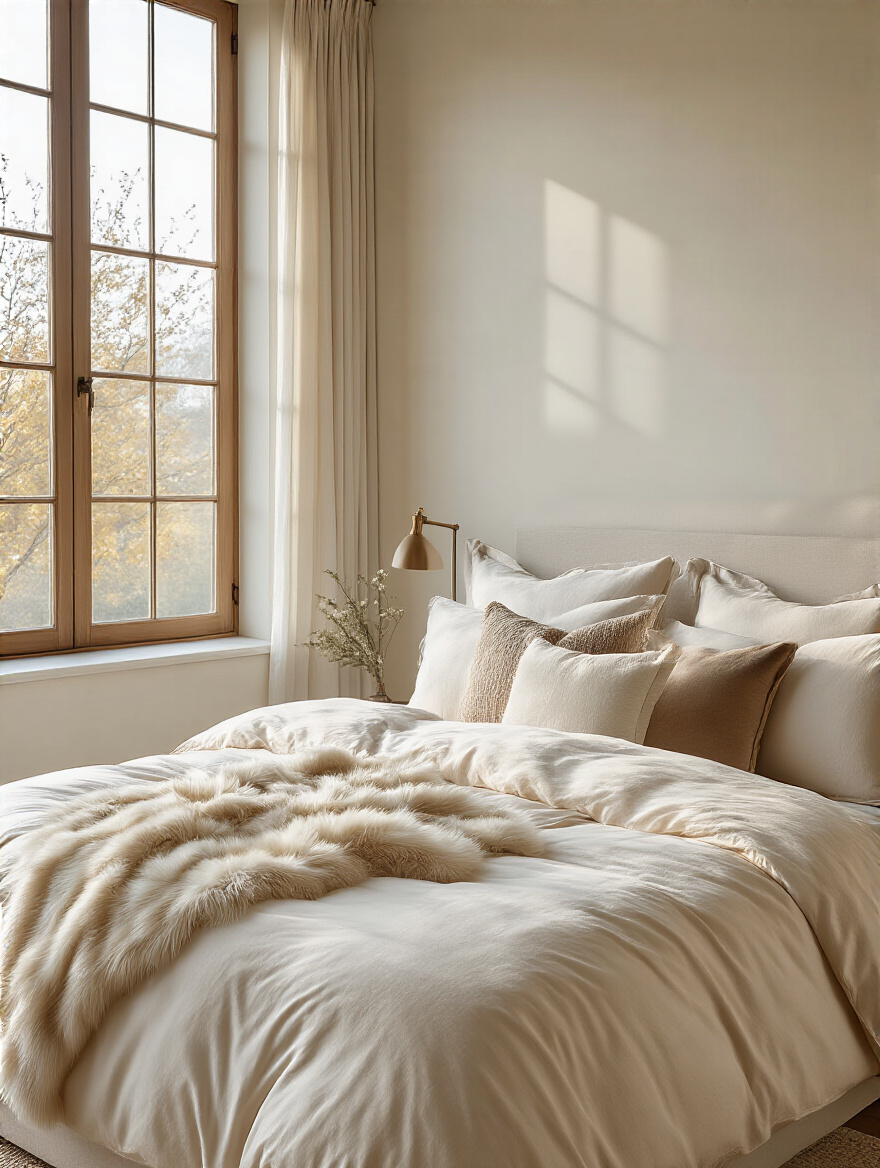
The secret is to mix materials. Combine the crispness of percale with the softness of a velvet quilt and the ruggedness of a chunky wool throw. This variation is what makes the bed look and feel luxurious and inviting. You’re creating visual depth and giving yourself options. Feeling a little cold? Pull up the quilt. Just need a little weight? The throw blanket is right there. This isn’t just about looking good; it’s about functional, adaptable comfort.
This tactile experience shouldn’t end at the edge of the bed.
7. Add Plush Area Rugs to Insulate Floors and Muffle Sound
The first thing your feet touch in the morning and the last thing they touch at night has a massive impact on your sense of comfort. Stepping out of a warm bed onto a cold, hard floor is a jarring sensory shock. A plush, high-pile area rug instantly solves this, providing a soft, warm landing that makes the transition into and out of bed so much more pleasant.
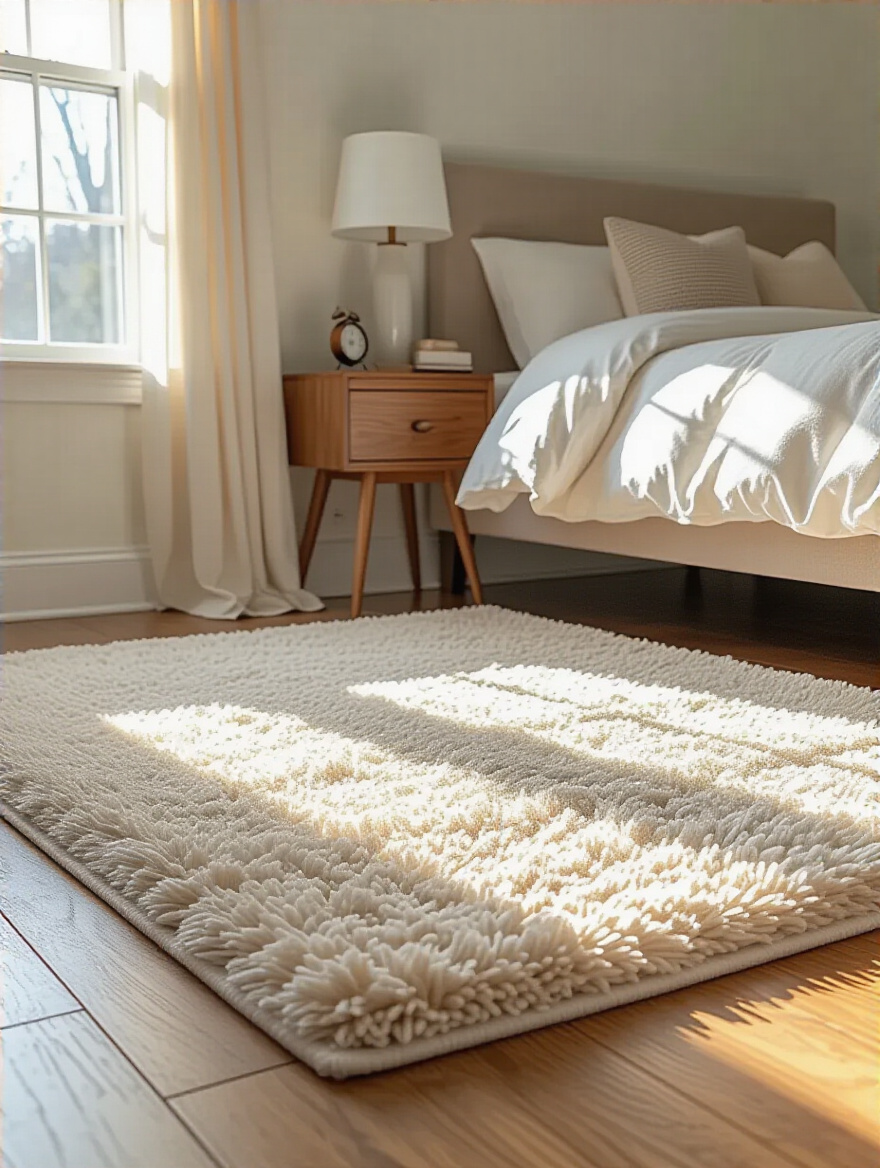
But a rug does more than that. It’s a powerful tool for sound absorption. Hard surfaces like wood or tile floors bounce sound waves around, creating echo and making a room feel stark and noisy. A thick rug with a quality rug pad underneath will literally soak up that ambient noise, making your room feel significantly quieter and more serene. It’s an acoustic trick that works wonders for creating a peaceful, insulated bubble where you can truly relax. Make sure the rug is large enough to extend at least 18-24 inches around the sides and foot of your bed.
Next, let’s scatter those tactile moments throughout the rest of the space.
8. Integrate Soft Throws and Decorative Cushions for Enhanced Coziness
This is where many people start, but it should be one of the finishing touches. Throws and cushions are the easiest way to inject texture, color, and personality. Drape a soft cashmere or faux fur throw over a reading chair. Arrange a few decorative cushions on the bed, mixing sizes, shapes, and materials (think velvet, linen, and knit).
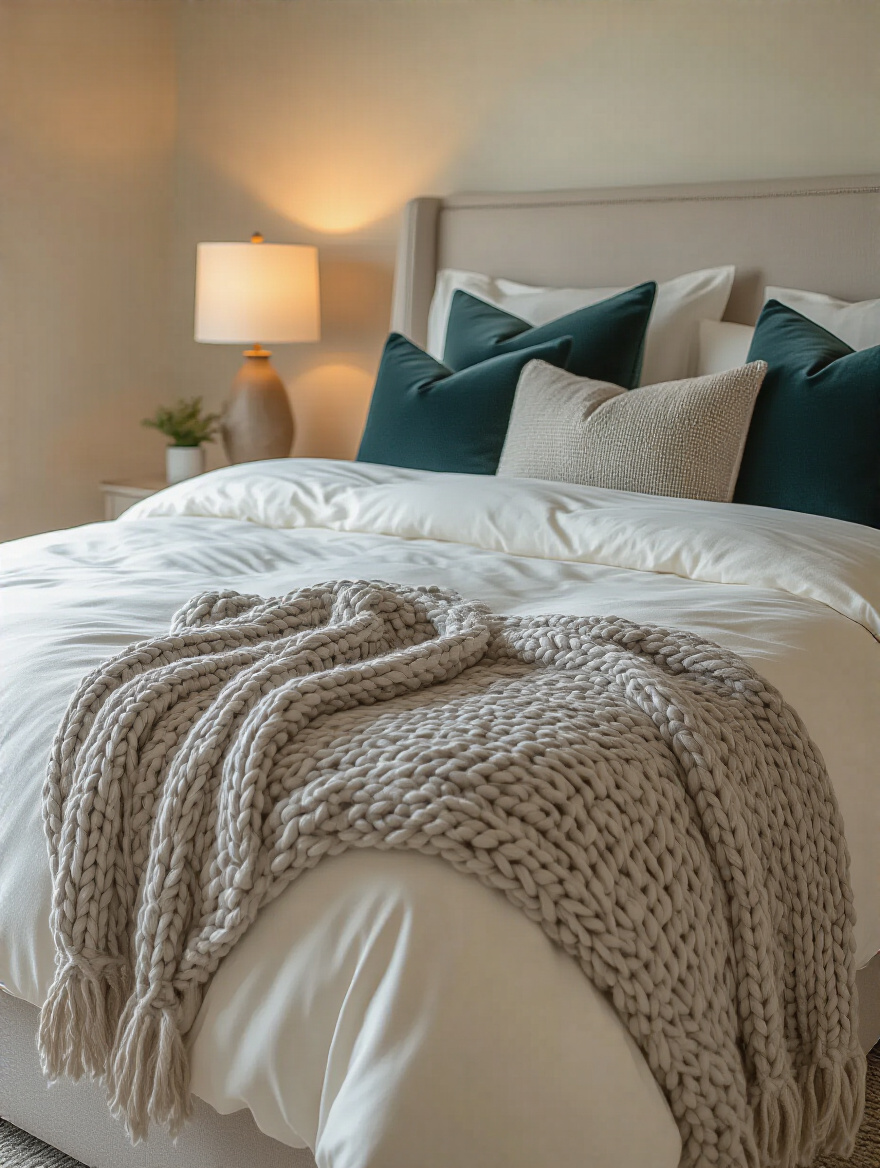
The BS to avoid here is going overboard. A bed drowning in 20 decorative pillows that you have to toss on the floor every night is not functional or relaxing; it’s a chore. The goal is curation, not collection. Stick to an odd number, like three or five, for a more natural and artful look. These elements should feel like an invitation to get comfortable, not like a museum display you’re afraid to mess up.
Finally, we address a crucial, invisible element: the air around you.
9. Optimize Room Temperature for Ideal Sleep and Relaxation
You can be surrounded by the softest materials in the world, but if you’re too hot or too cold, you’ll never be truly comfortable. The science is clear on this: to initiate sleep, your body’s core temperature needs to drop slightly. A cooler room facilitates this natural process. The sweet spot for most people is between 60-67°F (15.6-19.4°C).
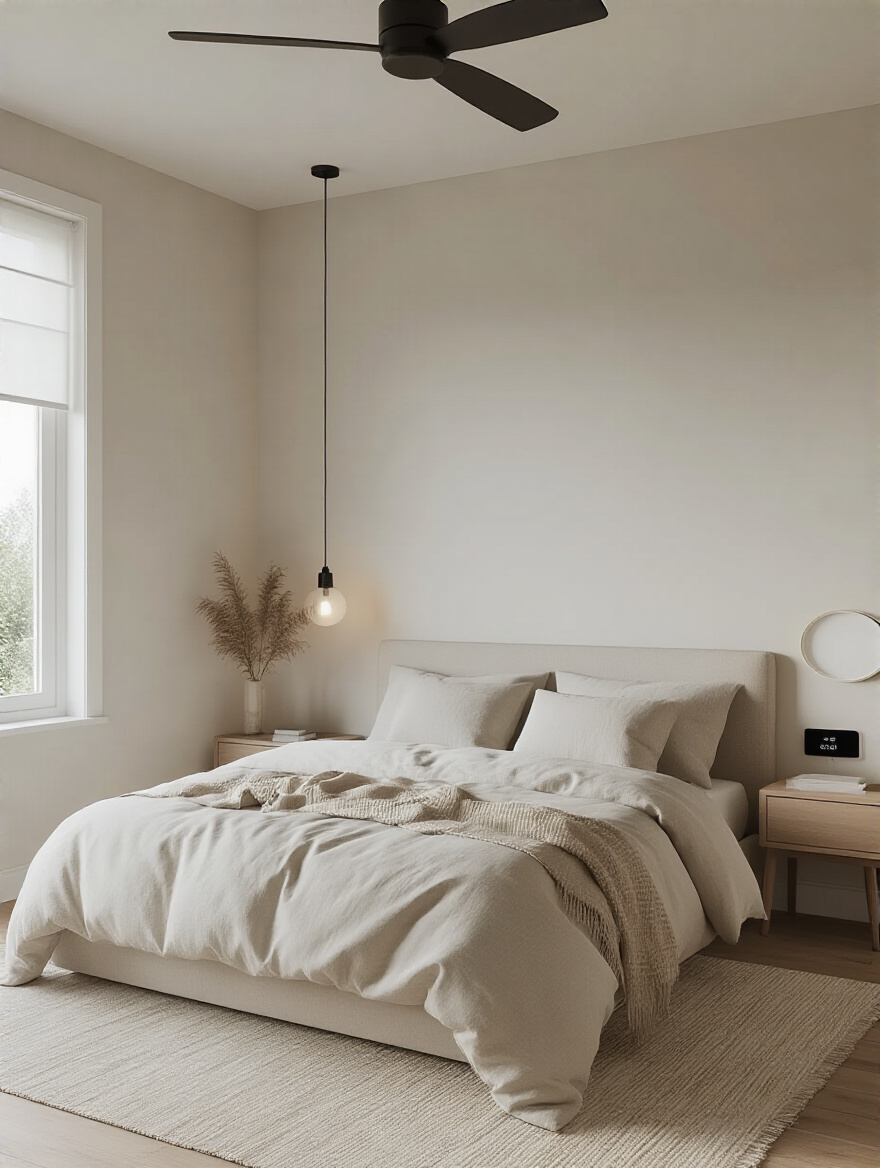
Setting your thermostat to cool the room an hour before you go to bed can significantly improve your ability to fall asleep and stay asleep. Think of it as creating the perfect “cave” conditions your body is evolutionarily programmed to seek for rest. Using breathable, natural bedding fibers will also help your body regulate its temperature throughout the night, preventing you from waking up sweaty and uncomfortable. This isn’t just a preference; it’s a biological necessity for deep, restorative sleep.
With the tactile and thermal environment set, let’s layer in one more sense.
Embracing Textures and Sensory Elements (Part 2)
We’ve covered sight, touch, and even temperature regulation. Now it’s time to engage one of the most powerful senses tied to memory and emotion: smell. A thoughtfully chosen scent can become the final, invisible layer that defines your bedroom as a true sanctuary.
10. Introduce Calming Scents with Essential Oil Diffusers or Candles
Scent has a direct pathway to the part of our brain that controls emotions and memory. You can use this to your advantage by creating a “scent signature” for your bedroom that your brain learns to associate with relaxation and sleep. This is about building a powerful subconscious cue that says, “Okay, it’s time to wind down.”
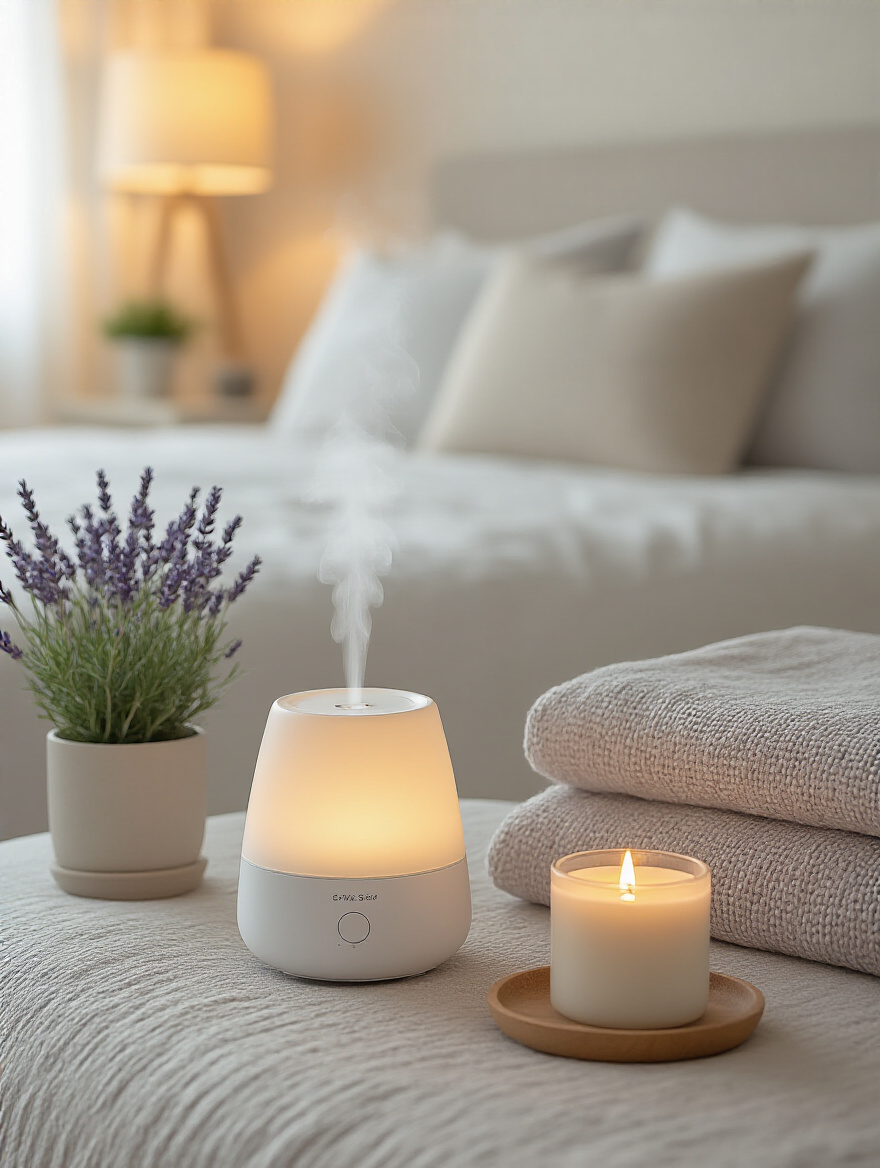
Choose calming, natural scents like lavender, chamomile, sandalwood, or cedarwood. An essential oil diffuser is a great flame-free option for gently dispersing scent. If you prefer candles, make sure they’re made from natural wax like soy or beeswax with pure essential oils, not synthetic fragrances that can be headache-inducing and overpowering. The key is subtlety. You want the scent to be a gentle whisper in the background, not a loud shout. Activate it for about 30-60 minutes before bed as part of your wind-down ritual to build that powerful sleep association.
Now we move from sensory elements to the personal touches that make the space uniquely yours.
Styling for Personalized Ambiance and Retreat
A truly cozy space is one that feels like a reflection of you. It’s filled with things you love and arranged in a way that supports your rituals. This stage is about personalizing the functional elements and adding decor that has meaning, transforming your bedroom from a generic space into your personal retreat.
11. Style Your Nightstands with Functional and Aesthetic Pieces
Your nightstand shouldn’t be a cluttered dumping ground for receipts, spare change, and old water glasses. It’s valuable real estate that should be styled with intention. Think of it as your personal command center for relaxation. Keep only the absolute essentials within arm’s reach: a glass of water, the book you’re reading, maybe some hand cream or lip balm.
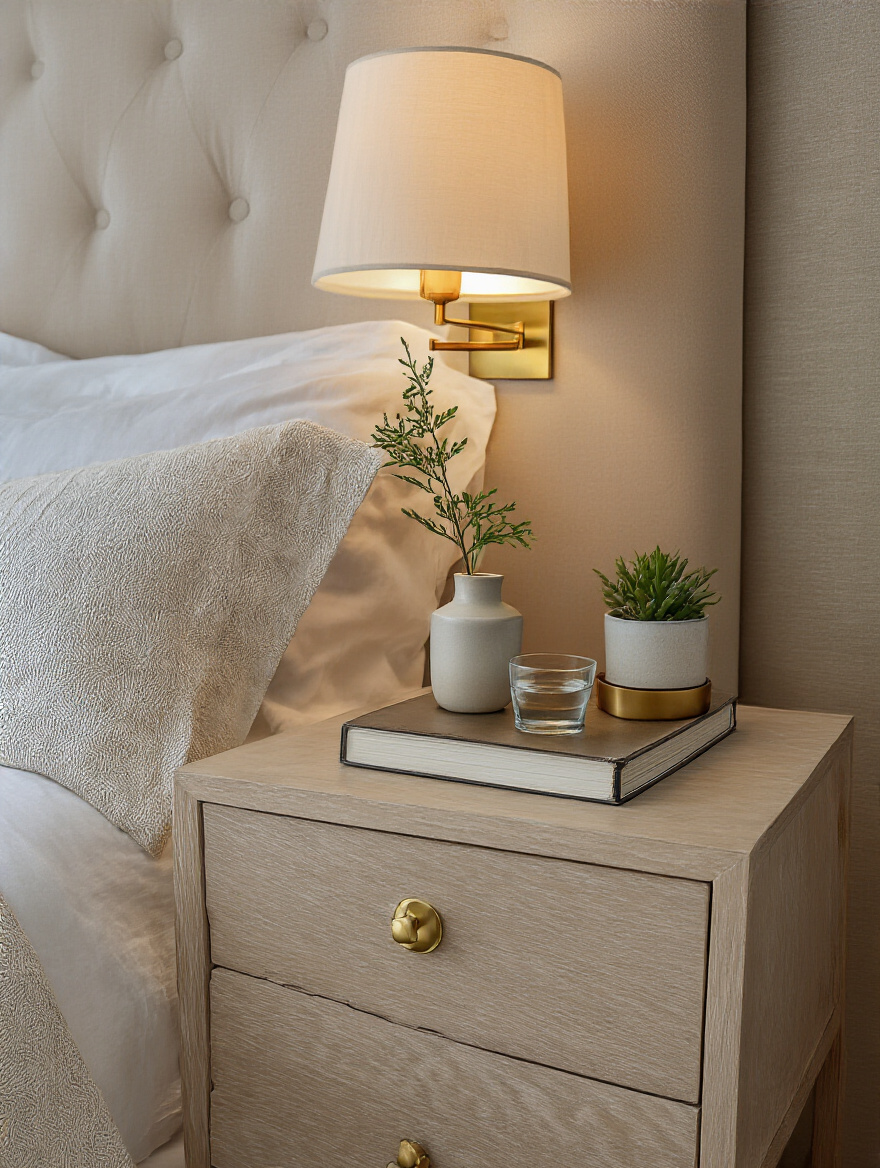
Once you’ve cleared the clutter, style it. Start with a lamp that provides good reading light (a task light!). Add a touch of life with a small plant or a single stem in a bud vase. Use a beautiful tray or a small ceramic dish to corral smaller items like your watch or earrings. By making this small surface both beautiful and highly functional, you bring a sense of order and calm right next to where you sleep.
That sense of order should extend to the art on your walls.
12. Personalize Your Space with Curated Art and Meaningful Mementos
This is your chance to surround yourself with things that bring you joy. Ditch the generic, mass-produced “art” from big-box stores. Your walls are a place to tell your story. Frame personal photographs from a favorite trip, display a piece of art from a local artist you admire, or hang a beautiful textile you picked up on your travels.
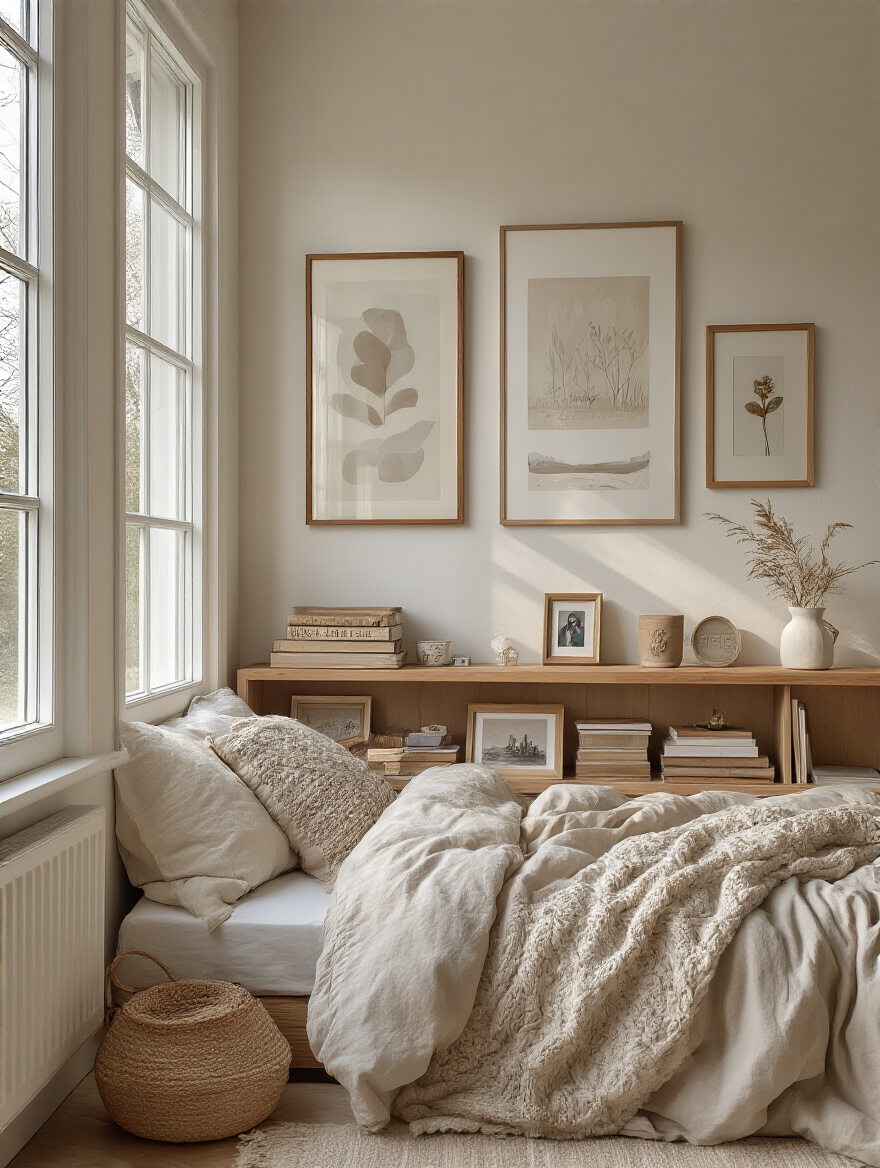
The key is “curated.” Don’t feel obligated to hang up everything you own. Select a few key pieces that have genuine emotional resonance for you. Create a small, balanced gallery wall or let a single, larger piece make a statement. When you’re surrounded by images and objects that remind you of happy moments and beautiful things, you reinforce the feeling that this room is your safe, happy place.
Let’s bring some of that beauty to life.
13. Bring Life and Freshness with Easy-Care Indoor Plants
Plants are a shortcut to making a room feel more alive, calm, and healthy. They literally breathe life into a space. They also help purify the air and, through a process called biophilia, their presence has been shown to reduce stress and promote feelings of well-being. Don’t worry if you don’t have a green thumb.
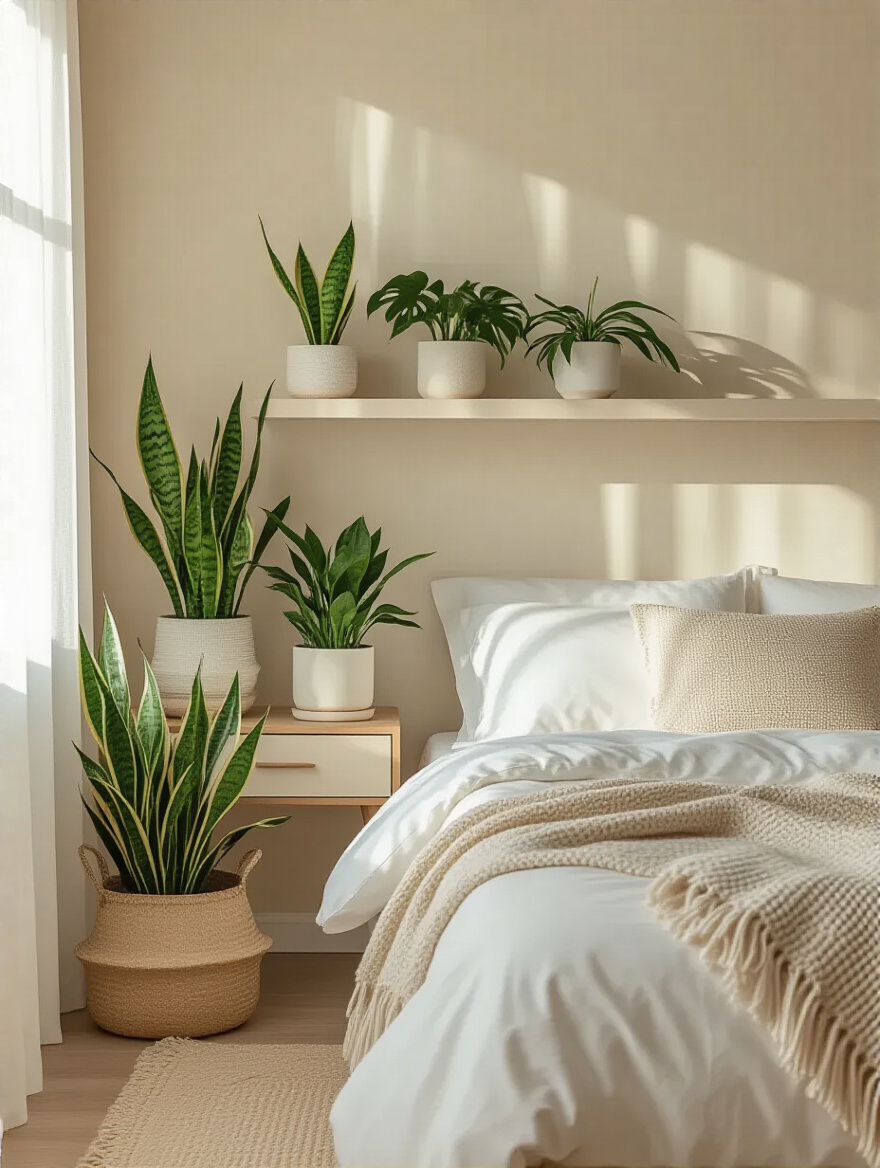
Start with notoriously hard-to-kill plants like the Snake Plant, ZZ Plant, or Pothos. These guys can tolerate lower light conditions and are forgiving if you forget to water them occasionally. Place one on a dresser, let a trailing pothos cascade from a high shelf, or put a larger snake plant in a corner. The pop of green and organic texture softens the hard lines of a room and connects your sanctuary back to the natural world.
Now, let’s talk about the structure of your bed itself.
14. Consider a Canopy Bed or Upholstered Headboard for an Enveloping Feel
A tall, upholstered headboard or a canopy bed can fundamentally change the feeling of your sleep space. These architectural elements create a sense of enclosure, a “room within a room” that makes your bed feel like a protected cocoon. An upholstered headboard adds a soft surface to lean against while reading and also helps absorb sound, making the space around your head feel quieter.
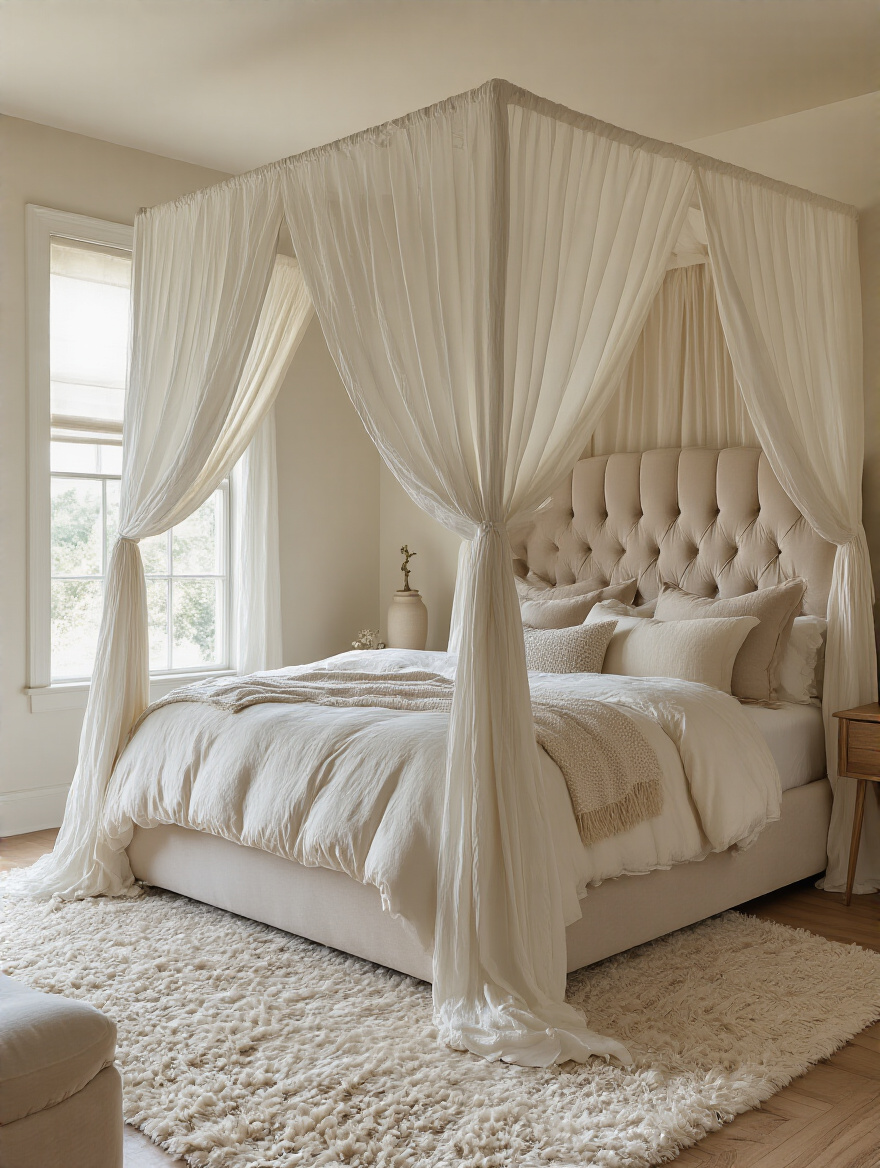
A canopy bed, even one with a simple frame and light, airy drapes, enhances this feeling of intimacy and privacy. It psychologically separates the sleep zone from the rest of the room, reinforcing the idea that this is a special, protected area designated solely for rest. It’s a powerful visual cue that transforms a simple bed into a grand, enveloping retreat.
With the design in place, let’s add a few final, advanced touches to perfect the experience.
Advanced Touches and Sustaining the Serenity
We’ve built the foundations and styled the space. Now it’s time for the pro-level tweaks that lock in the serene atmosphere. These final touches are about perfecting the sensory environment and then, crucially, creating simple habits to maintain the peaceful haven you’ve built.
15. Achieve Deep Sleep by Effectively Blocking External Light
Remember how warm, dim light helps you wind down? The flip side is that any light when you’re trying to sleep is a signal to your brain to stay alert. I’m talking about total, absolute darkness. Not just closing the blinds, but eliminating every single photon of light you possibly can. This is critical for maximizing melatonin production and getting into the deepest, most restorative stages of sleep.
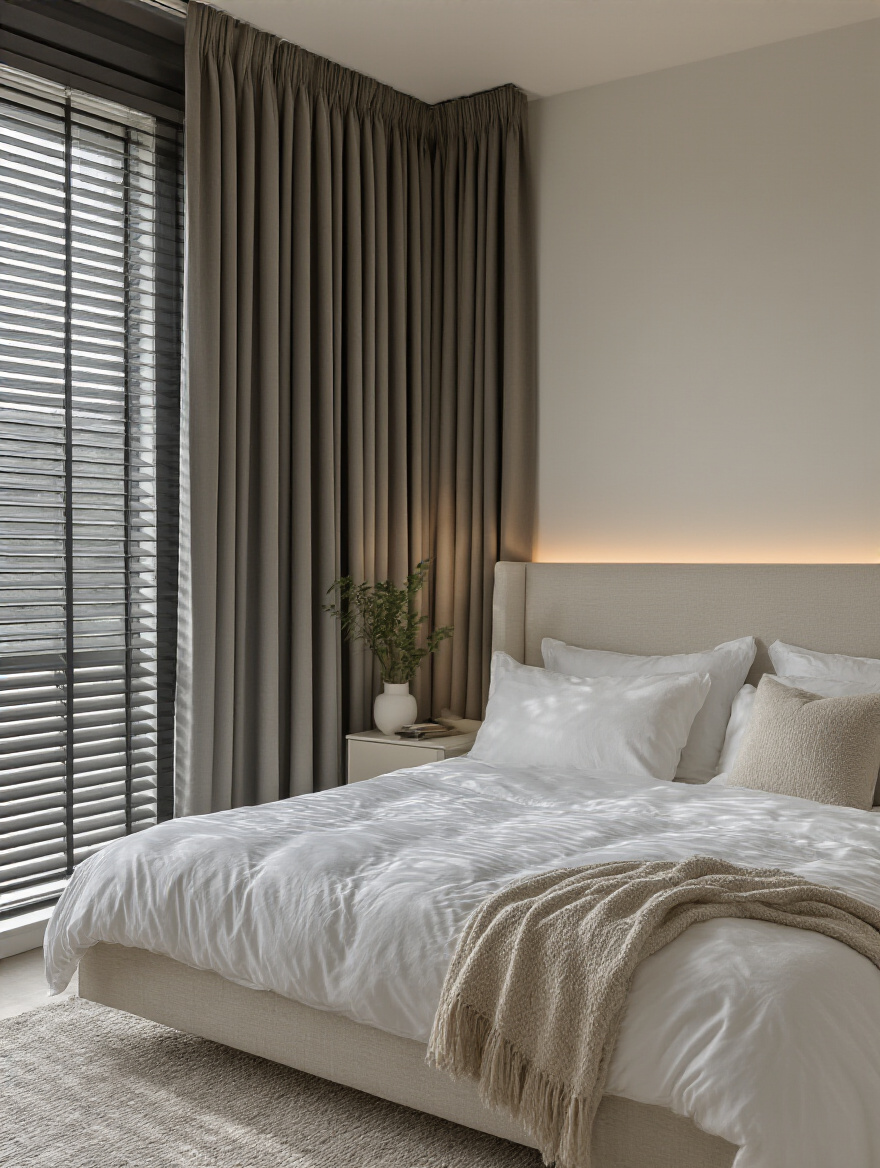
The solution is high-quality blackout curtains or cellular shades that are fitted to block light leaks from the sides. And then you go on a hunt. Put black electrical tape over the tiny, bright LED indicator lights on your TV, computer, smoke detector, and power strips. Turn your alarm clock to face the wall. If light still creeps in from under the door, use a door draft stopper. A good-fitting, contoured sleep mask is also a fantastic and affordable tool for achieving 100% darkness.
Now that we’ve eliminated disruptive light, let’s control disruptive sound.
16. Integrate Gentle Ambient Soundscapes or a White Noise Machine
Sudden, intermittent noises—a car alarm, a dog barking, a neighbor’s door slamming—are incredibly disruptive to sleep. A white noise machine doesn’t just add sound; it creates a consistent, soothing audio blanket that masks those sudden disturbances. Your brain learns to tune out the consistent hum, so when an abrupt noise happens, it’s less likely to jolt you awake.
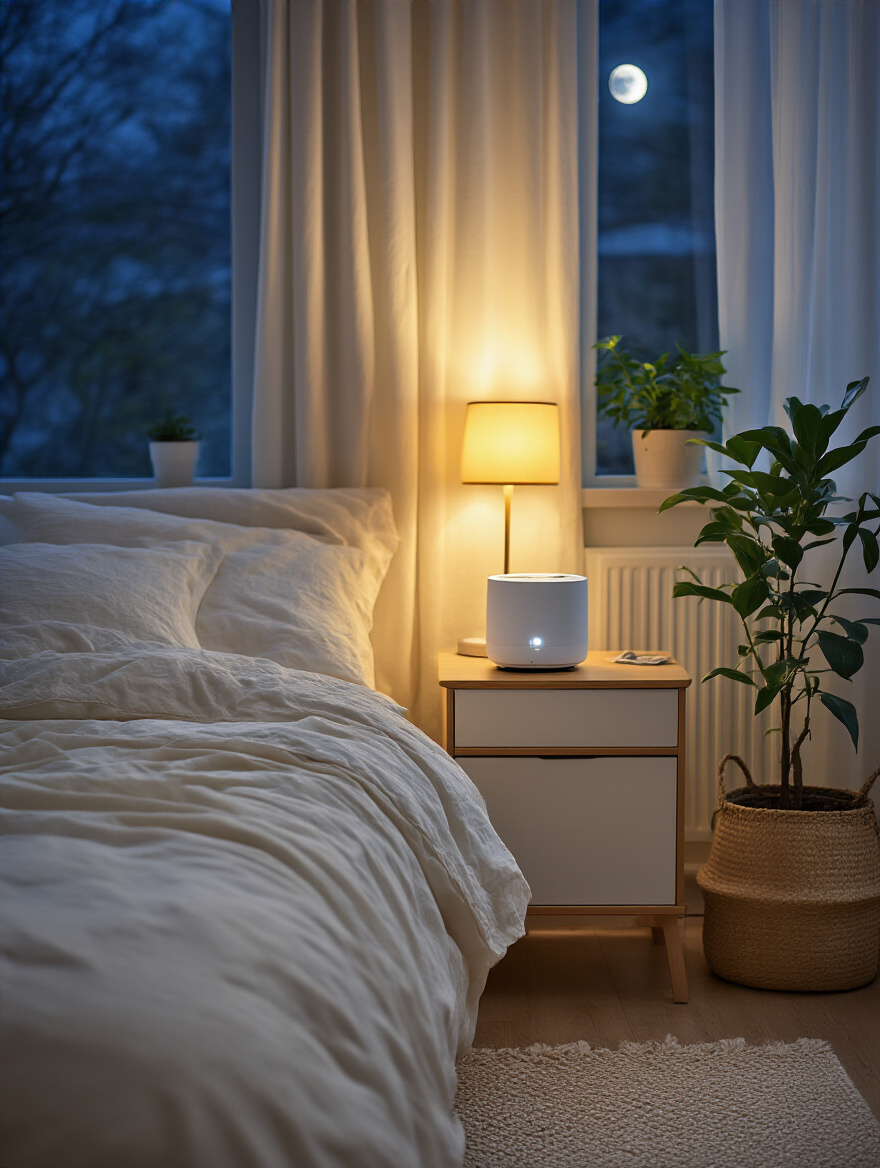
You don’t have to use pure white noise. Many people prefer the sound of gentle rain, ocean waves, or even brown noise (a lower-frequency sound). The goal is to find a sound that is constant and calming to you. A dedicated machine is often better than a phone app because it avoids the temptation to check your screen and won’t be interrupted by notifications. The steady, predictable sound creates a stable audio environment that can significantly deepen and consolidate your sleep.
Next, we reinforce the primary purpose of the bed.
17. Carve Out a Dedicated Reading Nook or Comfortable Lounge Spot
This is a powerful psychological trick: your bed should only be for sleep and intimacy. Not for working, not for eating, and not for endless scrolling. When you mix activities, you dilute your brain’s association between your bed and sleep. By creating a separate, dedicated spot for winding down—even if it’s just a comfy armchair and a small table in the corner— you strengthen that connection.
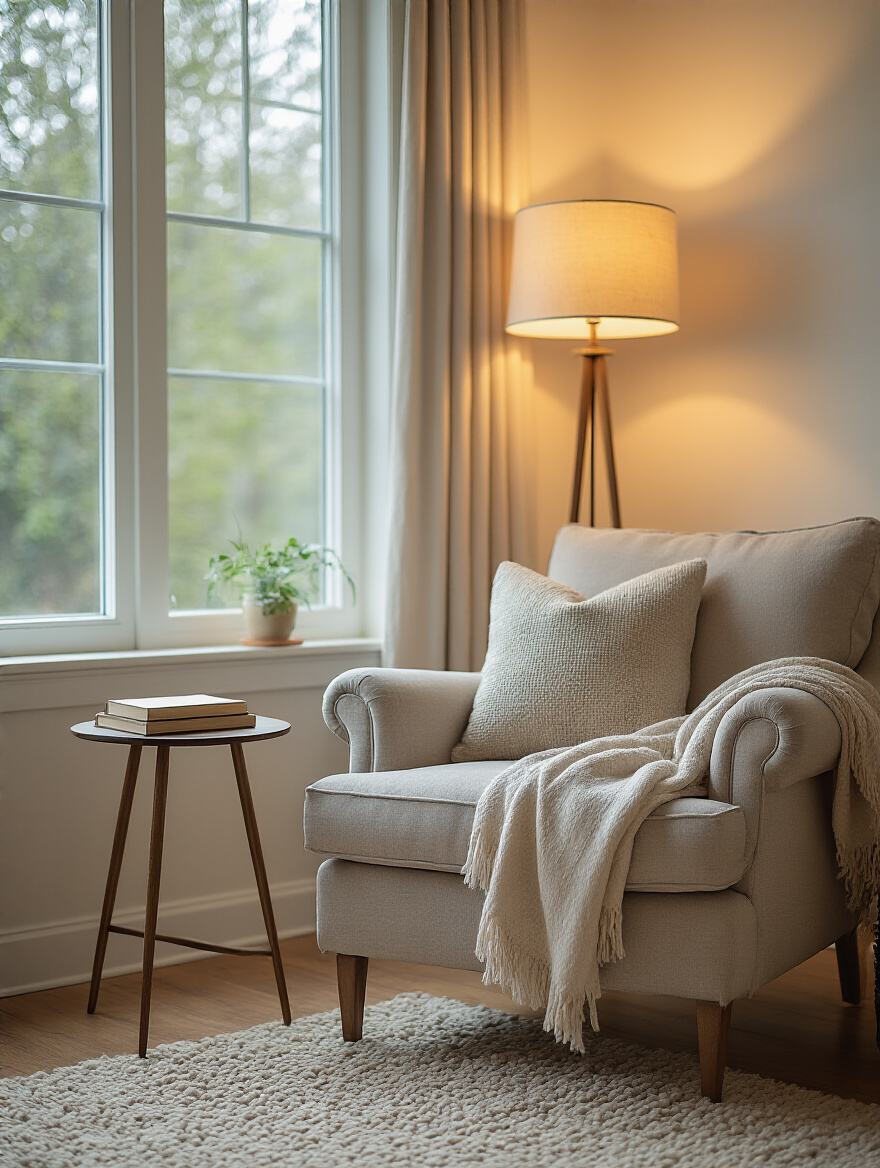
Equip this nook with everything you need for relaxation: a comfortable chair, a soft throw, and most importantly, good task lighting. A floor lamp with a warm, dimmable bulb is perfect for reading without straining your eyes. Spending 30 minutes in your nook reading a physical book before bed is a fantastic wind-down ritual that transitions you perfectly from the day’s stress to a state of sleep-readiness, leaving the bed as the final destination for rest.
And finally, the most important step of all: maintenance.
18. Maintain Coziness with a Regular Cleaning and Tidying Routine
You can do all this work, but if you let the room descend into chaos after a week, you’re back at square one. A cozy sanctuary cannot coexist with clutter and mess. The only way to sustain that feeling of serene calm is to build a simple, unbreakable routine. It doesn’t have to be a huge chore.
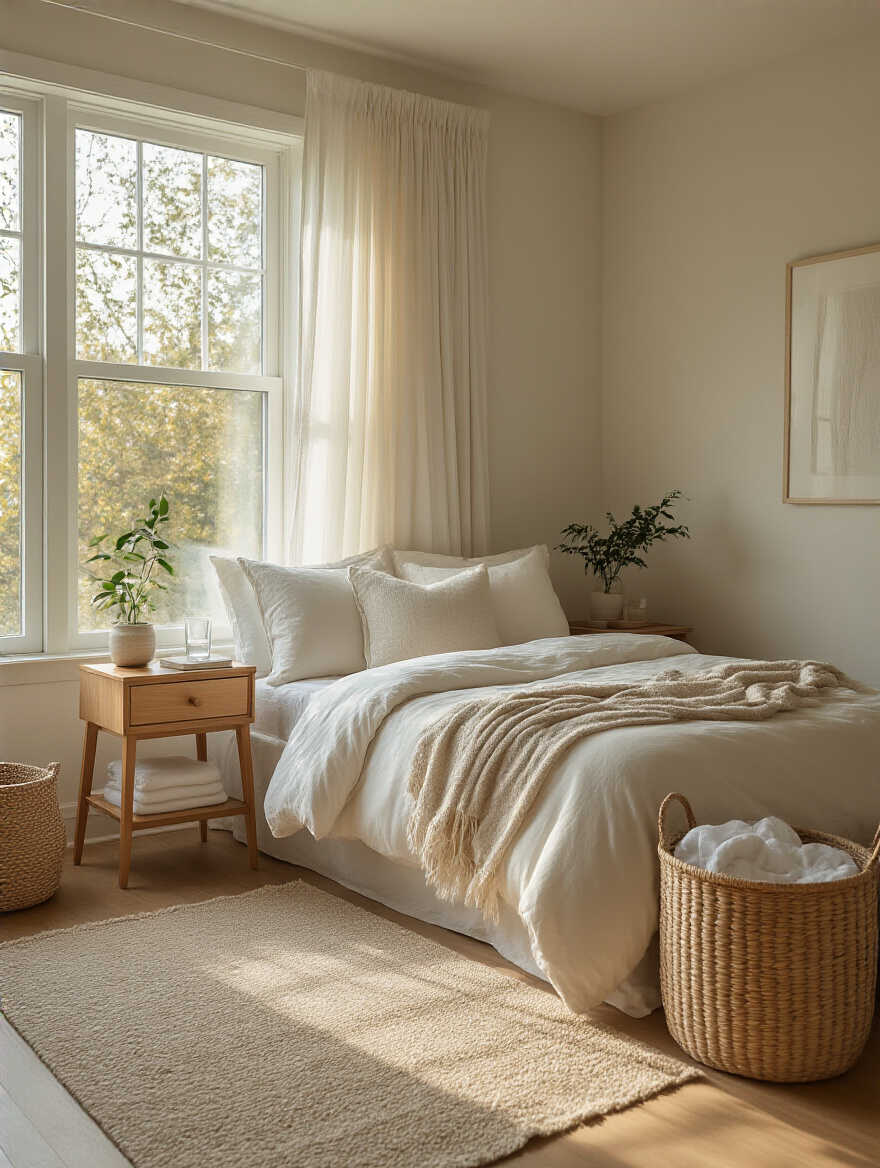
Spend five minutes every single morning making your bed. It’s a keystone habit that instantly makes the entire room look more pulled-together. Before you go to bed, do a quick 2-minute “reset”—put away the clothes you took off, clear your nightstand, and put your book back. Once a week, do a proper dusting and vacuuming. This isn’t just about hygiene; it’s about protecting the calm, orderly atmosphere you’ve worked so hard to create. A well-maintained space is a well-loved space, and that feeling is the very essence of coziness.
Conclusion
So there you have it. Creating a truly cozy bedroom has almost nothing to do with buying the latest trendy decor and everything to do with building a thoughtful, multi-sensory system. It’s about understanding that a serene layout, layered lighting, curated textures, and personal touches all work together to send a powerful, consistent message to your brain: “You are safe here. It’s time to rest.”
Don’t get overwhelmed and feel like you have to do all 18 of these things at once. Start with one. Install a dimmer switch. Declutter your nightstand. Buy a single, high-quality plant. You’ll be amazed at how one small, intentional change can start to shift the entire feeling of your space. You have the power to transform your bedroom from just a place where you sleep into a sanctuary that actively restores your mind and body. Now go build it.
